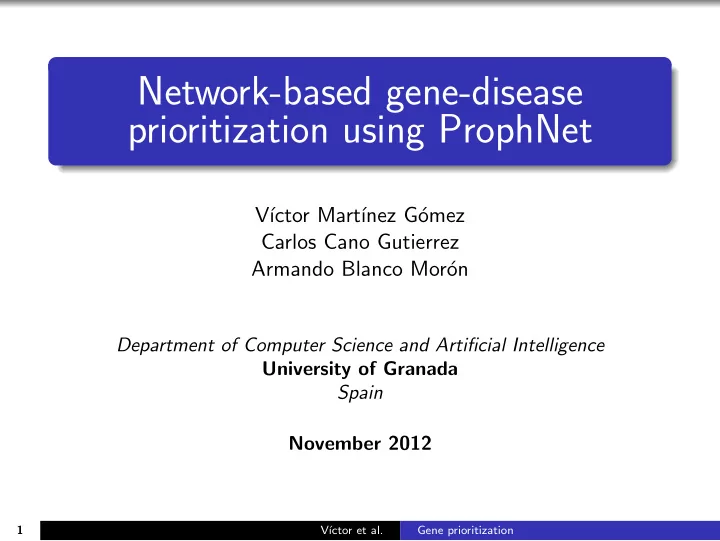

Network-based gene-disease prioritization using ProphNet V´ ıctor Mart´ ınez G´ omez Carlos Cano Gutierrez Armando Blanco Mor´ on Department of Computer Science and Artificial Intelligence University of Granada Spain November 2012 1 V´ ıctor et al. Gene prioritization
Fundamentals Prioritization Prioritization aims to identify the most promising biological entities among a larger pool of candidates through integrative computational analysis of genomic data. These methods are based on guilt-by-association hypothesis. Guilt-by-association hypothesis Biological entities showing a similar behaviour or sharing in- teractions/relations are more likely to belong to the same biological process, to be functionally related or to share mo- lecular basis. 2 V´ ıctor et al. Gene prioritization
Prioritization strategies Several prioritization strategies have been proposed: Filtering Text-mining Profiling Network-based 3 V´ ıctor et al. Gene prioritization
Network-based methods Advantages Better average performance than other approaches under similar conditions. Biological information is usually easy to representate as networks. Disadvantages Difficulties integrating an arbitrary number of data sources since network-based methods usually are limited to 2 networks. Very specific methods that do not allow to perform different types of queries. 4 V´ ıctor et al. Gene prioritization
ProphNet ProphNet is a network-based prioritization method. Allows integration of an arbitrary number of networks. Outperforms recently proposed methods. Flexibility in queries allowing any prioritization task (e.g., genes-diseases or protein domains-genes). 5 V´ ıctor et al. Gene prioritization
Data representation Data of a particular type is represented by a network . Nodes represent biological entities (e.g., genes or diseases). Arcs represent interactions or relations . Networks are interconnected by other networks (e.g., gene-disease or domain-gene network) forming the Global Graph . 6 V´ ıctor et al. Gene prioritization
Definitions NETWORK 5 (Target Network) Target set NETWORK 4 Path 1 Path 2 Path 3 NETWORK 2 NETWORK 3 NETWORK 1 (Query Network) Query set 7 V´ ıctor et al. Gene prioritization
More details about data representation Nodes have variable values which will be updated based on the degree of relation with the query or target sets. Query and Target set nodes are initially assigned with a value. The rest are assigned to zero. Arcs have constant weights representing the strength of the interaction or the relation. Networks are represented as adjacency matrices . A normalization step is performed in order to decrease the influence of each node degree . 8 V´ ıctor et al. Gene prioritization
Propagation operations Propagation inside network Propagation to the next network 9 V´ ıctor et al. Gene prioritization
Used Global graph Global graph Genes/proteins Proteins domains Diseases/phenotypes 10 V´ ıctor et al. Gene prioritization
Algorithm ProphNet algorithm pseudocode 1: Query set values are propagated inside Query Network. 2: paths ← Compute all paths from Query to Target Net. 3: for each node e in Target Network do Set node e as Target Set and propagate values inside 4: Target Network for each path in paths do 5: for each step in path do 6: Propagate from current network to next network 7: Propagate inside next network 8: end for 9: end for 10: S e ← Correlate paths with Target Network values 11: 12: end for 13: Sort S x decrementally to obtain prioritized list 11 V´ ıctor et al. Gene prioritization
Validation tests ProphNet has been applied to obtain a prioritized list of genes for some diseases. Top ranked genes were related with query diseases. Three test have been performed to validate ProphNet. Against rcNet : LOO gene-disease prioritization and new associations prioritization. Against domainRBF : LOO domain-disease . Leave-one-out (LOO) test: Remove known A-B association, prioritize using A as Query Set and measure where B is ranked. 12 V´ ıctor et al. Gene prioritization
Recommend
More recommend